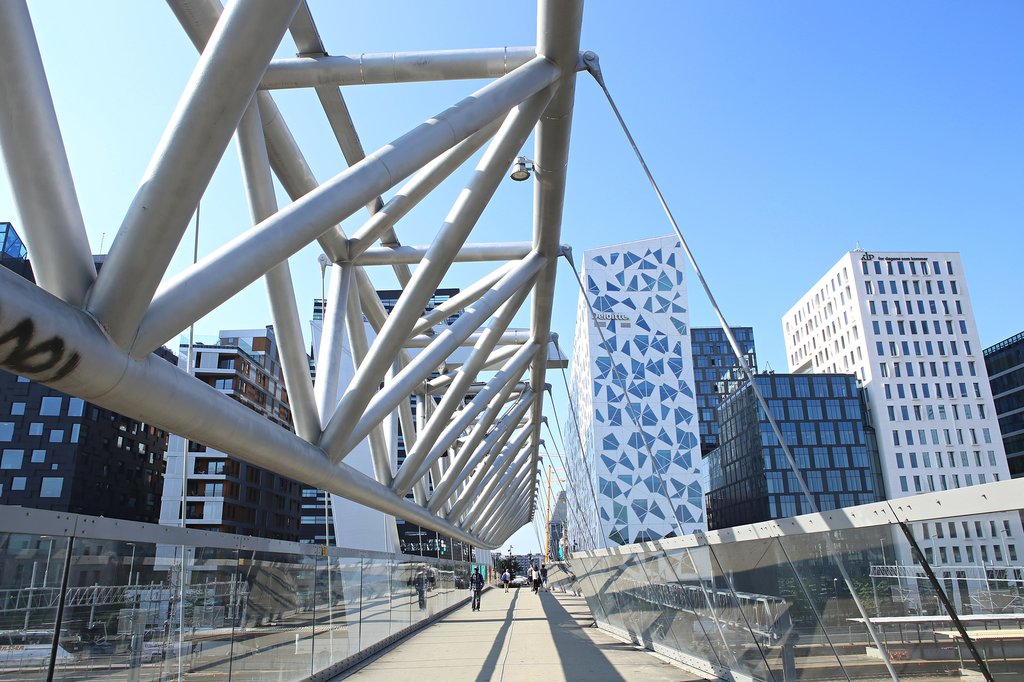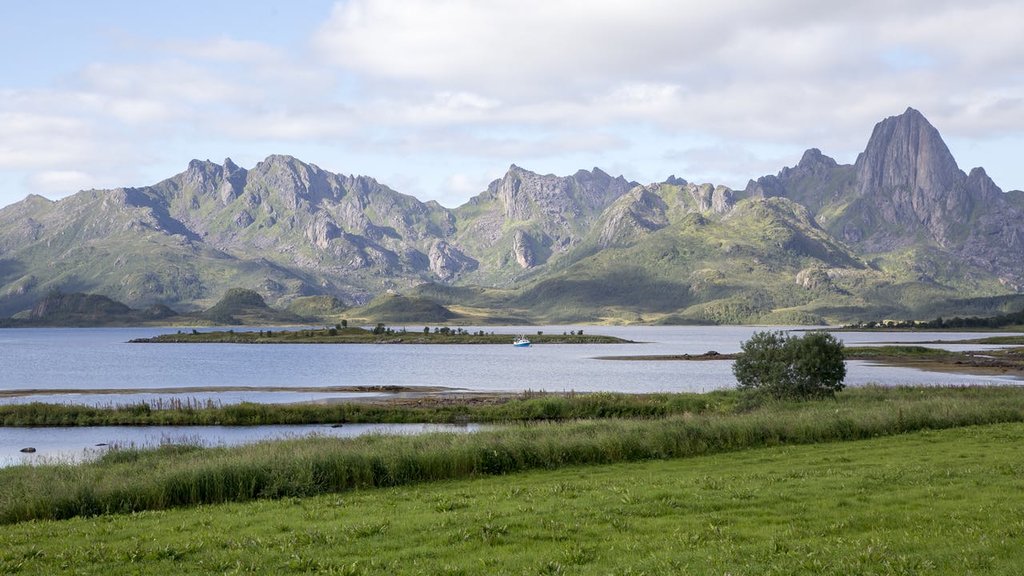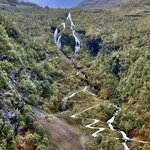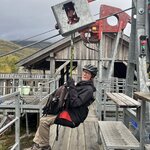Highlights
- Follow local experts on walking tours of Oslo and Bergen
- Ride the world's steepest and possibly most scenic railway in Flåm
- See if you can spot a sperm whale at their northernmost spot in Vesterålen
- Explore the dramatic natural landscape of the Lofoten islands
Brief Itinerary
| Day | Highlights | Overnight |
|---|---|---|
| Day 1 | Arrive in Oslo | Oslo |
| Day 2 | Oslo's Hidden Gems Tour | Oslo |
| Day 3 | Train to Flåm & Transfer to Aurland | Aurland |
| Day 4 | Flåm Railway & Cycling Trip | Aurland |
| Day 5 | Hiking in Aurland & Ferry to Bergen | Bergen |
| Day 6 | Bergen City Tour | Bergen |
| Day 7 | Flight to Bodø & Explore Bodø | Bodø |
| Day 8 | Drive from Bodø to Vesterålen | Vesterålen |
| Day 9 | Whale Watching in Andenes | Vesterålen |
| Day 10 | Drive to Svolvær & Explore Svolvær | Svolvær |
| Days 11 | Kayaking in Svolvær | Svolvær |
| Day 12 | Explore Lofoten & Drive to Å | Å |
| Day 13 | Ferry to Bodø | Bodø |
| Day 14 | Depart Norway |
Detailed Itinerary
Day 1: Arrive in Oslo

Welcome to Oslo! Norway's rapidly growing capital is still considered a small city, helped by the fact that it's surrounded by mountains and sea. Not only is the city center made for walking, but outlying neighborhoods—filled with charm and character—are easily accessible by public transportation, so jump on a tram, train, or bus and explore all of what Oslo has to offer.
Suggested activities include:
- Take a half-day and wander around Aker Brygge, an area on the Oslofjord made up of beautiful, modern buildings where you can find bars and abundant nightlife. It acts as a sort of courtyard for the city of Oslo and brings together both tourists and locals alike to enjoy the great food, atmosphere, and entertainment.
- Spend the afternoon visiting the Viking Ship Museum and the Norwegian Open-Air Folk Museum by way of public transportation. Both museums are in the same area, so they pair well together!
- Walk along the Havnepromenaden (harbor promenade)—a new five-and-a-half-mile waterfront park, which combines sightseeing, history, art, architecture, and a little bit of adventure.
- Visit the Vigeland Sculpture Park, where 200 larger-than-life sculptures are placed throughout this green lung in the middle of the city.
For dinner, explore the city's historic core buzzing with restaurants and cafés that stay cozy in cold weather, with several options that offer outdoor seating during summer months.
Day 2: Oslo's Hidden Gems Tour

After breakfast, you'll embark on an excursion to discover the real Oslo in the most authentic way possible: with a local expert guide. And there's quite a bit to see in a relatively small space (it takes a mere 30 minutes to travel from one end of Oslo to the other by metro). The city is known for its rich history and museums, some of which celebrate the macabre works of the Norwegian expressionist painter Edvard Munch. Others recount fascinating maritime history in the form of stunning ships of the Viking Era, while others celebrate music and even ski history.
The guide will tailor the experience to your preferences and interests, or you can defer to their expertise as they lead you around the city on an impromptu adventure, but you can choose specific topic upfront.
-
Oslo Hidden Gems: This includes visiting the sites mentioned above as well as strolling the cobbled streets of Damstredet, in central Oslo. This historic road is lined with well-preserved wooden houses dating back to the late 1700s/early 1800s. A walk along the Akerselva River should not be missed either, as it is an iconic landmark in the city. Then, should you choose, you can visit Grünerløkka, a bohemian enclave that abounds with street art, funky cafes (which offer some of the best coffee in the world), dance clubs, and independent fashion boutiques. This is also the location of the Mathallen Food Hall, where you can savor the flavors of Norway and abroad at its more than 30 eateries. Here you'll find everything from paella and Southeast Asian street food to Norwegian cheeses and cured meats.
- Akerselva River Walk: On this tour, you'll take the tram to the Akerselva River, an important waterway which offers an abundance of local history. You will start with the Norwegian Museum of Science and Technology (on the north side of the river) and then head south to the Labour Museum (part of the Oslo City Museum) while your guide shares stories about the heart of Oslo's history. The river is five miles (8 km) long and passes waterfalls, swimming areas, forested areas, and wildlife, so bring your camera!
- Holmenkollen Ski Jump: If you have less time to spare, this tour heads for a popular area called Holmenkollen, where a wooded range of hills can be reached by light rail from the city center in about 35 minutes. Open year-round, the Holmenkollen Ski Museum & Tower presents over 4,000 years of snow sports, polar exploration, and an exhibition on snowboarding and modern skiing. Head for the observation deck offering panoramic views of Oslo, and then walk down to the ski jump while your guide shares stories about local trolls, legends, and castles.
- Food & Drinks: Join your guide for local food and drinks, coffee, and aqua vitae.
Day 3: Train to Flåm & Transfer to Aurland

Head to the train station for your transfer westward towards the village of Flåm.
This journey will take you through some of the highest train track elevations in the world. From small villages to remote countryside, the views from your window will be nothing short of spectacular. At its highest point, the tracks will take you 4,009 feet (1,222 meters) above sea level!
After a quick train-change in Myrdal, you will continue on to Flåm via the famous Flåm Railway. Enjoy views of snow-covered mountains, deep fjords, and beautiful waterfalls as you make your way towards your destination. The train even makes a special stop at the Kjosfossen waterfall for photo ops.
You will arrive in Flåm just in time for lunch. You can also check out the Flåm Railway Museum and learn about the challenges faced by Norwegian engineers during the construction of the Flåm Railway tracks.
From Flåm, transfer to the quiet, charming neighboring village of Aurland where you will spend the night.
Day 4: Flåm Railway & Cycling Trip

Pedal your way through the landscape today with a bicycle tour. You'll pick up your rental bike in Flåm, then hop aboard the Flåm Railway for the journey up to Myrdal along one of the world's most scenic and steepest train rides.
Once you've been transported to the top, it's time to make your way back down through the stunning Flåmsdalen valley under your own power. Stop whenever you feel compelled to take in the view as you gradually return to Flåm. You'll then head back to Aurland for the evening.
Day 5: Hiking in Aurland & Ferry to Bergen

Today, after a hearty breakfast, you'll explore Aurland's stunning surroundings with a local guide on a hiking trail. This half-day excursion heads to a spot called Hovdungo, situated 2,559 feet (780 m) above the beautiful Aurlandsfjord. From here, you'll enjoy spectacular views of mountain landscapes and the fjord. The hike is listed medium in difficulty, however, some parts of the trail are very steep. From the top, you'll be rewarded with one of the best fjord views in the area before you make your way back on the same trail (you'll also stop for lunch during the hike).
In the afternoon, it's time to head to the quay to catch your fjord cruise to Bergen. Sit back and enjoy the views of Norway's longest and deepest fjord, the Sognefjord, arriving in the evening. Once you're settled in your hotel, hit the cobbled streets of this historic city for dinner!
Chat with a local specialist who can help organize your trip.
Day 6: Bergen City Tour

After enjoying breakfast, meet up with a local guide for a tour of Bergen, the second-largest city in Norway, with about 300,000 residents. Rich in culture and history, this walkable city boasts a nice offering of food and drink options, along with activities to suit any traveler.
Be sure to take the Fløibanen funicular (or hike up the trail on foot) to the top of Mount Fløyen for the best view of the city, and leisurely stroll back down the path while discovering the hidden troll sculptures along the way.
Also, check out the Bryggen area of downtown to view old wooden houses dating back to the 1700s, along with Bergen's best historical sites and museums. For a rest, stop in one of the local coffee shops in Bryggen and warm up with a hot drink and pastry.
Throughout your day, enjoy cuisine from one of the many restaurants in the the city and stop in for coffee, tea, and pastries at one of the traditional Norwegian bakeries.
Day 7: Flight to Bodø & Explore Bodø

Today, take a domestic flight to Bodø. Northern Norway’s second-largest city sits just above the Arctic Circle, offering scenic strolls, a classy culinary scene, and a great starting point to explore Lofoten, the route along the Helgelands coast to Trondheim, and other parts of the region.
You have the day to explore on your own if you so choose. Visit the Norwegian Aviation Museum and Nordlands Museum, or stay outside and stroll along Mjelle beach.
If you'd prefer a guided experience, you can hop in a Zodiac boat to experience the world's strongest tidal current at Saltstraumen. This roaring current will also take you through the stunning scenery while you get up close with the elements and learn about Norway's coastal heritage.
Rather stay on land? Take a guided Arctic coastal walk in the Norwegian tradition of Friluftsliv, enjoying the great outdoors. Your guide will describe the geology of the area, tell you about the local history and explain the Norwegian dependence on the sea. You'll also see one of the many Viking graves discovered in this area.
Day 8: Drive from Bodø to Vesterålen

After breakfast in Bodø, you will have a long but very scenic drive ahead of you (180 mi / 290 km) to Sortland, centrally located in the Vesterålen islands. Enjoy the drive through Nordland county and admire the beautiful scenery, stopping along your route to snap plenty of photos. You will take the ferry from Bognes to Lodingen along the way.
Once you arrive, settle into your hotel and enjoy a relaxed evening.
Day 9: Whale Watching in Andenes

Drive for around 1.5 hours to Andenes on Andøya Island, within the Vesterålen archipelago.
Nature lovers will be in heaven here amidst the varied landscapes which span from calm and peaceful beaches to craggy, alpine mountains and dramatic fjords.
Most Norwegians know Andenes as a year-round whale-watching destination and the northernmost point in the world where you can observe sperm whales. Even short trips offer a good chance of spotting a whale, so take the afternoon to enjoy a 2-4 hour boat trip with a local whale-watching operation, where you can get a glimpse of the mighty sperm whales as well as other aquatic life and seabirds.
After the whale watching tour, enjoy the rest of the day in Andenes before you drive back to your hotel for the night.
Day 10: Drive to Svolvær & Explore Svolvær

Drive from Vesterålen to Svolvær within the Lofoten islands.
While this is the busiest village and the de facto capital of Lofoten, it still only has a population of fewer than 5,000 people. As the regional center, the town has lots of shopping opportunities and a range of hotels, high-class restaurants, and art galleries open for business throughout the year. Anywhere you look, the view will be magnificent!
The local economy is much more diverse than you might expect. Cod fisheries, particularly during winter months when tourism is low, remain an essential economic foundation for the town. You can't go far in Lofoten without seeing cod hung up on racks to dry, and this is true even in the biggest town.
Svolvær is also the main starting point for tours to the Trollfjord, one of Norway’s lesser-known but most dramatic fjords. Take a rigid inflatable boat (RIB) cruise through the extremely narrow fjord, which runs for just over 1 mile (2 km).
Day 11: Kayaking in Svolvær

Explore the world-renowned Lofoten Islands by kayak. Your local guide will help you get acquainted with your kayak and equipment, teaching you basic paddling techniques. Once you're comfortable in the shallow water, head out into the sea and enjoy the views of small islands, expansive bays, and sandy beaches.
Keep an eye out for local wildlife, including seals, otters, and seabirds. Europe’s largest bird, the white-tailed sea eagle, lives in the Lofoten Islands. After a break to rest and enjoy a snack, your guide will lead you back to Svolvær as you navigate around the rocky shoreline.
Day 12: Explore Lofoten & Drive to Å

Your ultimate destination today is Å, at both the southern tip of Lofoten and the end of the Norwegian alphabet. But take your time getting there, as there's plenty to explore in Lofoten along the way.
Your island options include:
- Gimsøya: Only 35 minutes from Svolvær, the island of Gimsøya has beautiful nature and rich birdlife. Hike up the easy Hoven mountain trail for views of the midnight sun and islands all the way out to Vesterålen. It's also home to the world's northernmost golf course and a horse farm with Icelandic horses
- Eggum: This fishing village on the seaward side of Vestvågøy island is a great place to experience the midnight sun, complemented by the intricate artwork of Marcus Raetz.
- Unstad: You don't need to be in California to hang ten; this is the world's most northern Arctic surf resort, with the chill vibes to match.
- Bøstad: This little village is home to the Lofotr Viking Museum and an annual Viking festival that celebrates those seafaring traditions. Don't miss the Glasshytta glassblowing workshop.
- Nusfjord: This section of the drive is surrounded by steep mountains, with a small, charming harbor and red rorbu awaiting in the village.
- Ramberg: Stop here for a stroll along the long, sandy beach.
Day 13: Ferry to Bodø

Come back to Bodø via car ferry for your last evening in Norway. Stop in at any museums and shops you missed on your previous visit and enjoy a Norwegian dinner.
If you’re feeling ambitious, hike up to the mountain plateau of Keiservarden on top of Veten Hill for a view all the way out to the Lofoten islands. You can also drive halfway if you aren’t feeling up for a challenge, or drive out to Turisthytta for an equally stunning view. For an indoor view, ascend to the 17th floor of Scandic Havet for a panorama of the city and surrounding area.
Day 14: Depart Norway

Although it's time to say goodbye to Norway, the memories from your trip will surely stay with you forever.
Map








